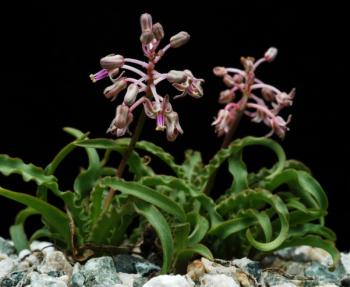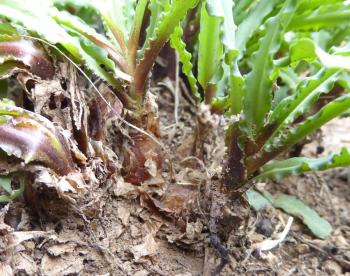Ledebouria crispa
Ledebouria crispa S.Venter
Family: Hyacinthaceae
Common names: Polokwane African hyacinth
Introduction
Although rare in cultivation, this interesting dwarf ledebouria with its narrow, strongly crinkled, green to grey grey-green leaves, makes an attractive pot subject. In its natural habitat in Limpopo Province, South Africa, the species is rare and only known from a few isolated locations.

Description
Description
A deciduous bulbous plant forming clustered groups of numerous bulbs, growing in small, dense colonies, bearing strap-shaped, semi-fleshy, grey-green leaves, with strongly undulating margins.

The bulbs are pear shaped and covered with membranous, pale brown outer layers, with a pronounced bulb neck of up to 30–40 mm long.

The flowers are produced in spring on unbranched spikes bearing numerous single flowers arranged along the central peduncle (main stalk), each on a short pedicel (flower stalk). The small, pinkish green flowers have strongly recurved tepals (petals) and pink filaments (anther stalks). The green capsules split open to reveal the black wrinkled seeds. The small, drop-shaped seeds are produced following the flowers in spring.

Conservation Status
Status
This species is assessed as Endangered (EN) on the Red List of South African Plants as there are less than five known populations occupying a total area of less than 300 km2, and the known locations are threatened with habitat loss due to urban expansion, as well as quarrying of rock and overgrazing in the areas where it occurs.
Distribution and habitat
Distribution description
This species is highly localized and known from only a few locations in the hills east of the city of Polokwane, Limpopo, South Africa. The species occurs on rocky ridges where it is usually found between schist rocks sometimes hidden under vegetation.

Derivation of name and historical aspects
History
The genus Ledebouria is named in honour of the German-Estonian botanist, Professor Carl Friedrich von Ledebour (1785–1851). The species name crispa, which means ‘curly’ in Latin, is in reference to the undulate (curly) margins of the leaves.
The genus Ledebouria has close to 100 species extending from India across the Arabian peninsula southwards though Africa down to South Africa, with the highest level of diversity in the eastern side of southern Africa centered in the Mpumalanga and Limpopo Provinces. New species are constantly being discovered in this highly variable group of plants, with three new species being named in 2015.
South Africa has 43 Ledebouria species, of which L. crispa is probably the one with the most undulate leaves. This species is most easily confused with L. atrobrunnea which has leaf margins only undulate towards the base, erect paler more milky green leaves and the dry bulb scales a much darker brown. L. atrobrunnea also does not usually form such dense colonies of numerous bulbs, unlike that of L. crispa.
Ecology
Ecology
Little is documented about the ecology of this species. The flowers are open and cup-shaped, which suggests that they are opportunistically pollinated by most visiting insects, although honey bees have been seen visiting the flowers in cultivation, along with smaller solitary bees. The seed is small and roundish and it is suggested in one text that Ledebouria seed are dispersed by water wash, which is likely after heavy thunderstorms which are frequent in the areas where the species occurs.
Uses
Use
Although Ledebouria. crispa has no specific citations as being used by people, the genus Ledebouria has been cited as having been used medicinally for purposes including pregnancy, diarrhoea, influenza, backache, skin irritations, wound treatment as well as lumbago. The genus is also reported as being poisonous, although it is also reported that bushmen eat the bulbs of certain species (L. apertiflora and L. revoluta).

Growing Ledebouria crispa
Grow
Ledebouria crispa is easily cultivated in an organic, rich loam soil with good drainage, the addition of sifted kraal (cattle) manure, bonemeal and coarse sand is beneficial. Adult plants prefer to be grown in terracotta pots which facilitate quick drying of the soil after rain. They prefer a warm climate with watering in the form of heavy downpours between each period of almost drying out during summer, and should be kept in full sun to obtain the best leaf colour and curliness. During the dry winter dormancy period, the pots should be moved out of the rain and placed in a cool dry area with good air movement. Watering can commence at the onset of warmer weather in spring (September to October in South Africa).
Propagation from seed is a very successful method of producing more plants. Fresh seed should be sown in spring or summer in seed trays filled with a sifted organic loam with some sifted manure and sand added to facilitate good drainage. The seed can be sown on a firmly tamped surface and lightly covered with the same mixture approximately 3 mm deep. The trays should be kept in a bright, warm, well-ventilated position out of direct sunlight, and kept damp for between 2 to 3 weeks until germination has commenced. Once the seedlings have emerged watering can be reduced. The seedlings can remain in the seedling tray for 1 year and planted out at the beginning of their second growing season. Flowering size bulbs can be attained after 3 to 4 years.
References
- Hankey, A. 2011-07. Ledebouria Roth (Hyacinthaceae). Internet 5 pp. http://pza.sanbi.org/ledebouria-genus
- Pfosser, M & Speta, F. 2001. Hyacinthaceae. Hyacinthus, Ornithogalum, Scilla and their relatives. Version 01 January 2001 (under construction). http://tolweb.org/Hyacinthaceae/21437/2001.01.01
- Venter, S. & Edwards, T.J. 1998. A revision of Ledebouria (Hyacinthaceae) in South Africa. 2. Two new species, L. crispa and L. parvifolia, and L. macowanii re-instated. Bothalia 28(2): 179–182.
- Venter, S. 2008. Synopsis of the genus Ledebouria Roth (Hyacinthaceae) in South Africa. Herbertia 62: page range?.
- von Staden, L. & Winter, P.J.D. 2008. Ledebouria crispa S.Venter. National Assessment: Red List of South African Plants version 2015.1. Accessed on 2016/03/27
- Wordnik. https://www.wordnik.com/words/crispa accessed 27/03/2016
Credits
Andrew Hankey
Walter Sisulu National Botanical Garden
May 2016
Plant Attributes:
Plant Type: Bulb
SA Distribution: Limpopo
Soil type: Loam
Flowering season: Spring
PH: Neutral
Flower colour: Green, Pink
Aspect: Full Sun
Gardening skill: Easy
Special Features:
Horticultural zones









Rate this article
Article well written and informative
Rate this plant
Is this an interesting plant?
Login to add your Comment
Back to topNot registered yet? Click here to register.